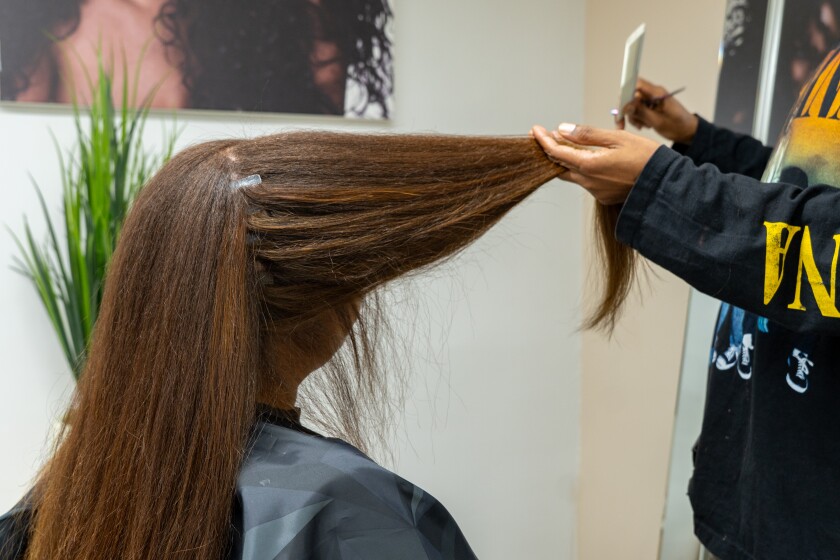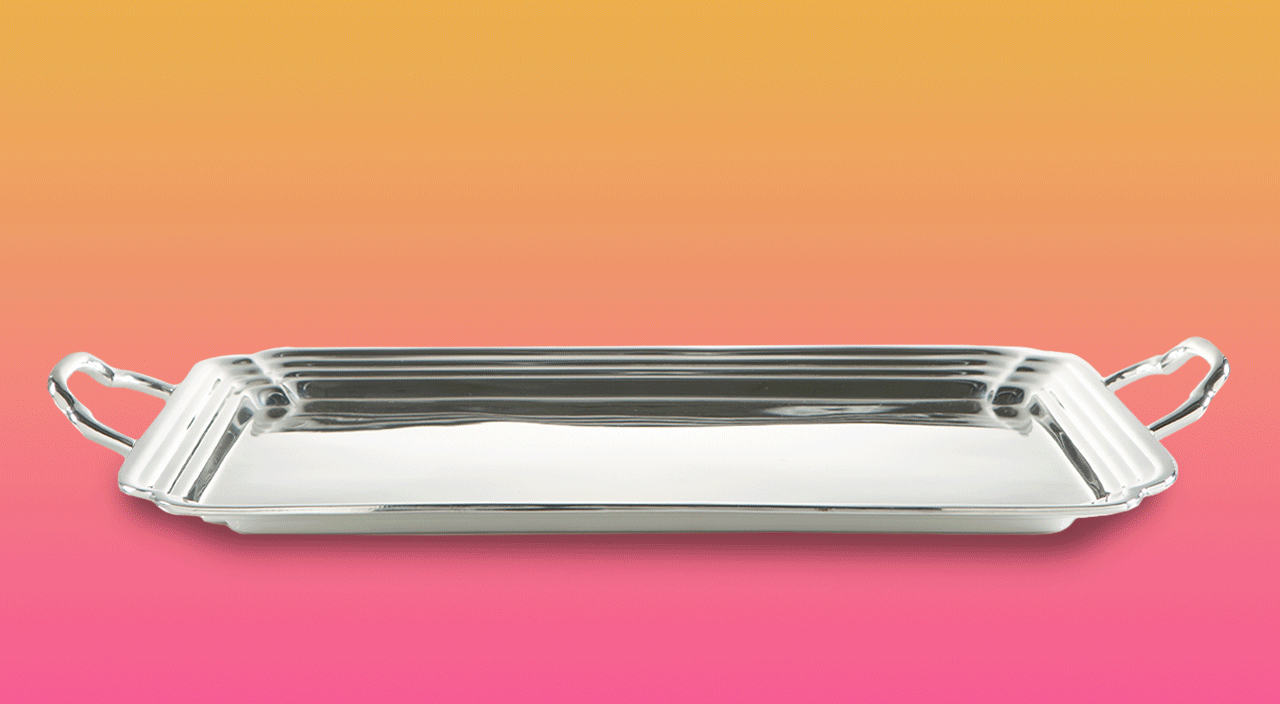Have you thought about a new look? Share your thoughts in the comments below.
We’ve all seen those viral videos of women undergoing dramatic hair transformations at the hands of talented stylists. Natural-looking results, seemingly happy clients and regained self-esteem — too good to be true? Turns out, the hype is real, Sis! And those viral hairdos you’ve seen all over your timeline are known as “hair integration systems.” They might be a solution if you struggle with alopecia-related hair loss or thinning due to thyroid issues or hormonal changes.
So, what are hair integration systems anyway? Despite what the name suggests, no surgery is involved! They typically include attaching extensions to one’s natural hair using mesh, beaded wefts of hair or double-sided tape.

“The mesh integration system is ideal for those with thinning or super fine hair, especially if the scalp is visible [or if there’s] patchiness,” explains Karen Mitchell, licensed cosmetologist and CEO/Founder of True Hair Company with over 20 years of experience in hair sourcing and development. “It involves breathable mesh in which the client’s natural hair is pulled through and then blended with the hair extensions.”
“The beaded weft method is suitable for those with medium to thick hair, for people who want volume in length without braids or adhesives,” adds Mitchell, whose A-List clients include Rihanna, Serena Williams, Mary J. Blige, Tyra Banks, Taraji P. Henson, Cardi B and Megan Thee Stallion. “The tape-in system [is] really for those who want a semi-permanent but natural look with minimal tension. The extensions are attached with a medical-grade adhesive, lying super flat against the scalp, and looking very natural. You could pull your hair back in a ponytail [if you wanted to].”
Truth be told, that only scratches the surface of the world of hair integration systems. Read on for what else you need to know before trying them out for yourself. Remember to check with your doctor first to determine if they’re safe and suitable for you.
10 Things to Know:
Who is and is not a candidate for hair integrations?
Your hair loss needs to be relatively stable, meaning it shouldn’t get drastically worse month after month. There needs to be enough healthy follicles to blend in with the extensions. At the same time, the install won’t work if you have too much natural hair because the added hair needs to lie flat on the scalp. Otherwise, it’ll appear too bulky and therefore unnatural.
What might it cost?
Mesh integration installations start at around $300. Still, many stylists charge upward of $1,000 depending on several factors: the quality of hair used for the unit, the amount of coverage needed and where you live. Some salons may even require a deposit up front, so make sure you trust the stylist before sending over your hard-earned coins. If something doesn’t feel right, don’t be afraid to keep searching for the right salon.
What about potential damage to hair/scalp?

“Mesh integration will not damage your hair or scalp if properly [installed],” Mitchell says. “A mesh integration system protects the scalp from the weight and tension of traditional hair extensions.”
What’s left of your natural hair should still grow through the mesh. When your hair grows out, your stylist will need to retighten the installation (more on that below).
How much time is spent in a salon/barber’s?
For the initial install, be prepared to sit in your stylist’s chair for around two hours, give or take, depending on the severity of your hair loss. And be sure to carve out time in your schedule for re-tightening every four to six weeks.
“For tape-ins, it’s generally not considered retightening; it’s [more of] a redoing of the tape-ins—but retightening is necessary for the mesh integration system and beaded system,” Mitchell says. “The process involves repositioning and re-securing the integration closer to the scalp as the hair grows out, and that typically could take anywhere from one to three hours for retightening, depending on the hair density, the hair extension type, and the amount of hair growth that took place.”
Do they slip off or loosen? What does it feel like to have this thing stuck to your head for weeks?
Once installed by a professional, your mesh integration system should not budge, but it’s natural to need an adjustment every couple of months as your natural hair grows out. As far as comfort, Mitchell describes hair integrations as “lightweight,” saying they can “blend with your natural hair without interfering with your daily lifestyle.”
How long do the styles last?
Similar to a wig or color job, how long it lasts mostly depends on how well you take care of it between salon visits. Typically, installs last between two and three months, but if you’re physically active and hit the gym often or enjoy going for a swim in the warmer months, you’re looking at one to two months before retightening is needed.
“Going beyond three months can lead to tangling, matting, or even discomfort,” Mitchell warns. “Some people even [make it to] four months, which is okay.” For those new to the process, shorter intervals make sense.
How often should units be replaced?

Units can be made using synthetic or human hair, but Mitchell recommends the latter. “Most units are reusable and can last up to a year depending on the quality of the hair, and I always recommend raw hair extensions as opposed to synthetic hair,” she says. “It’s best to use human hair so you can reuse it [and style it] like you would your natural hair.”
What is maintenance like? Can you shampoo, swim, etc.?
Gentle shampoos and conditioners will help you get the most out of your install. A clarifying shampoo, which can be very stripping, is best left to the professionals, as it can weaken the extensions or adhesive. You’ll also want to avoid vigorous scrubbing and focus more on the ends than where the mesh lies. And let your hair air dry; if you must reach for a blow dryer, use it on the lowest heat setting or with a diffuser attached.
Three shampoo and conditioner options to try (prices subject to chagne): True Indian Hair Moisture Rich Keratin Shampoo and Moisture Rich Keratin Conditioner (TrueIndianHair.com, $20 each), Mizani Moisture Fusion Shampoo and Moisture Fusion Intense Moisturizing Mask Set (Target, $70), and Ouidad Curl Quencher Moisturizing Shampoo and Moisturizing Conditioner (Ulta, $24 each)
“Like other extension units, wigs, these can be washed at home with proper instructions from your stylist. However, salon maintenance is always recommended,” Mitchell advises. “It may need tightening when washing, so it’s best to be in a salon’s atmosphere where that can be done. Swimming is also fine... You just have to be aware of when you need tightening.”
Good to know: While swimming, wear a snug swim cap to prevent chlorine from eating away at the mesh and damaging the hair itself. If chlorine makes contact with your hair, shampoo and condition it as soon as you can get to a shower.
How can you find a stylist with this expertise?
If you want to discover new hair stylists and trends and find inspiration, Mitchell is a fan of Instagram accounts like The Cut Life, The Tease and Behind the Chair.
“Most clients who are looking for stylists for this kind of installation are doing so by word of mouth and social media,” Mitchell adds. “A quick hashtag search of #meshintegration or #hairintegration can locate a stylist within your area who specializes in these types of installations.”
Meanwhile, sites like Booksy and StyleSeat make it easy to narrow your search for stylists by typing in a brief description of the service(s) you need, followed by your location. Google is also your friend, so don’t underestimate the power of the internet to discover what expertise lies in your backyard.
What’s a different option?
It’s possible that you could fall into the “too much” or “not enough” healthy hair follicles category, so a hair integration system may not suit your needs, but not all hope is lost; there are other options you can try, like a topper, lace wig or hairpieces. “It all depends on the type and severity of the hair loss,” Mitchell says.
More pro tips:
• Sleep on a satin pillowcase or wear a satin bonnet to bed to prevent breakage and tangling.
• If the hair is past your shoulders, wear a loose braid or ponytail to keep it from matting.
• Avoid sleeping with wet hair.
Have you thought about a new look? Share your thoughts in the comments below.














